It looks like you're using an Ad Blocker.
Please white-list or disable AboveTopSecret.com in your ad-blocking tool.
Thank you.
Some features of ATS will be disabled while you continue to use an ad-blocker.
11
share:

We live in exciting times. It seems not a day goes by without a story about exoplanets, particularly potentially habitable (inhabited?) exoplanets.
Everyone by now is familiar with the bonanza of data from the Kepler space telescope (still being analyzed) which determined the statistical likelihood of other planets like the Earth in our Milk Way Galaxy which lead to the realization that there are likely tens of billions of other Earthlike worlds in our Galaxy.
Carl Sagan would be proud.
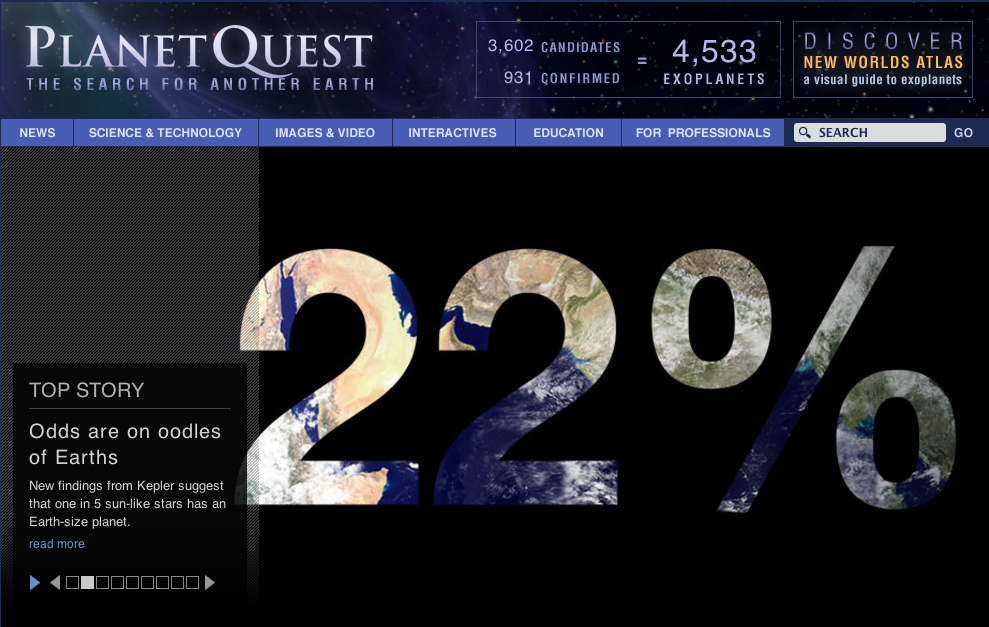
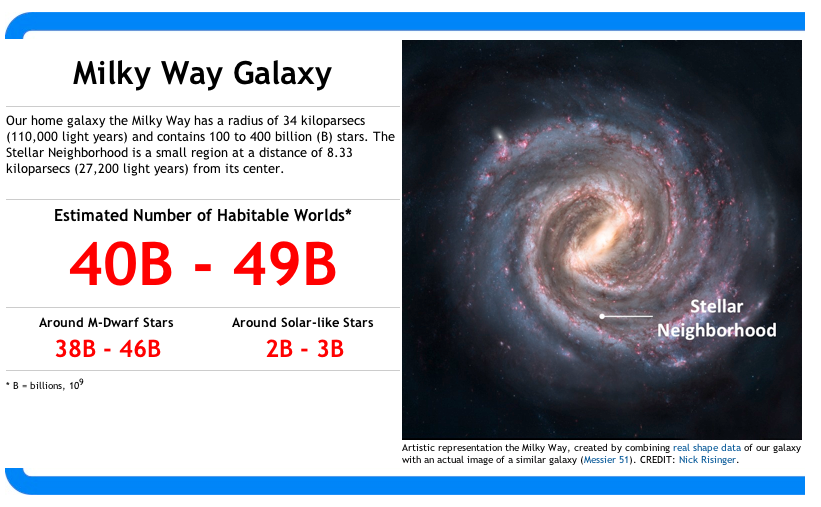
While the slice of sky, or field of view of Kepler was selected because it provided a statistically representative selection of stars in our galaxy, most of the stars in Kepler's field of view were fairly distant, averaging hundreds or even thousands of lightyears away.

This makes most of the planets and planet candidates Kepler has detected harder to study in detail. Which is a shame because based on the Kepler data, there is a 95% chance of another Earth (warm, wet, Class-M planet) in our Solar Neighborhood (also known as our Stellar Neighborhood - within 33 light years of the Earth).
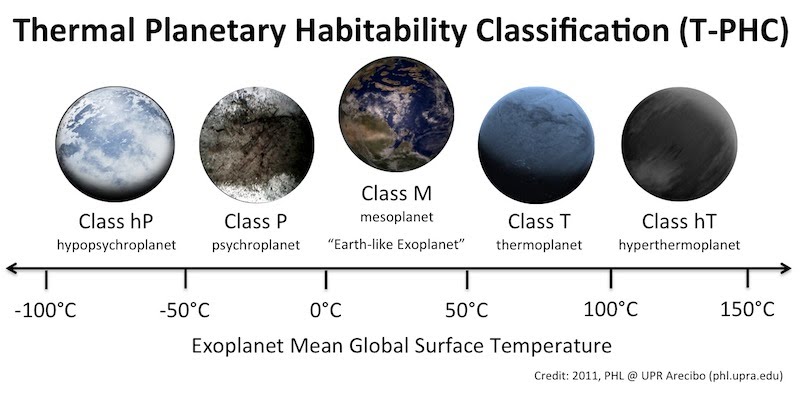
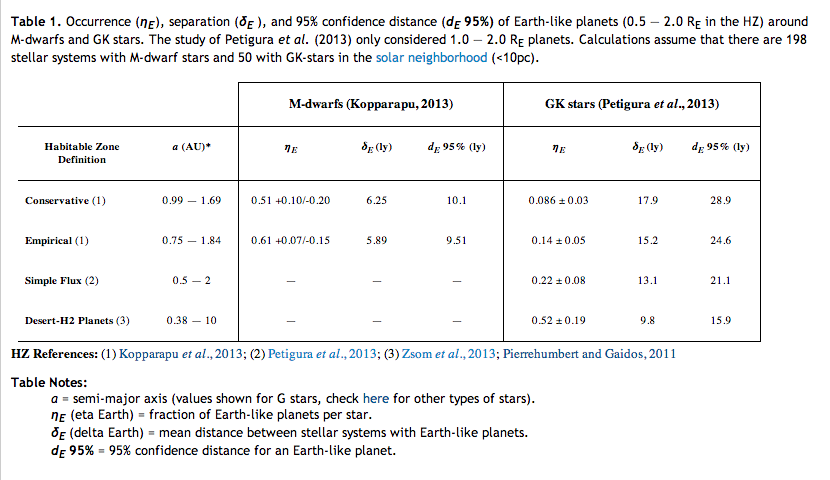
The good news is that several space telescope missions to look at the nearby stars, stars closer to the Earth for potential habitable worlds have received tentative approval.
The most recent of these is the European Space Agency's PLATO space telescope which reports today suggest has been given the green light for launch within the next 10 years.
A space-based observatory to hunt for habitable planets around other stars is the leading candidate to win the financial backing of the European Space Agency later this month.
The PLATO mission is tentatively slated to launch between 2022 and 2024 to a position a million miles away from Earth, where it will scan the sky for at least six years with 34 telescopes arrayed together to peer at a vast number of stars searching for the signatures of orbiting planets.
PLATO won the backing of an ESA science panel in January. The news was first reported by the BBC and confirmed by two sources familiar with the decision.
The mission will build on ongoing work by scientists using data from NASA's Kepler observatory, and researchers say PLATO will supply ground-based telescopes and the James Webb Space Telescope with planetary targets for follow-up studies.
PLATO will assemble a catalog of planets, measuring the size, mass, density and age of alien worlds about the size of Earth located at just the right distance from their host stars with hospitable temperatures that could support liquid water and life.
"We want to completely characterize low-mass planets out to the habitable zones, learn about their internal composition, the density, and the age of the system," said Stephane Udry, an astronomer at the University of Geneva, in a presentation of the mission in November.
Udry said PLATO will provide a "huge number" of planets for observations by future missions, which could reveal the nature of their atmospheres and chemical make-up.
Unlike Kepler, which imaged a narrow swath of the sky in the constellations Lyra and Cygnus, PLATO will scan two wide fields, staring at each for up to three years and collecting and analyzing light from a million stars.
The advisory panel's endorsement of PLATO now goes to ESA's science program committee to take up the decision to select the mission for implementation.
PLATO would become the third medium-class mission in ESA's "Cosmic Vision" program, which aims to develop strategic space science probes for solar system exploration and research in astronomy and astrophysics.
In addition to this, the crippled Kepler Space telescope itself may soon get a new lease on life which will see it examine 4 new fields of view along the plane of our solar system in a mission called K2. Many of the stars in these 4 new fields of view will contain nearby planets.
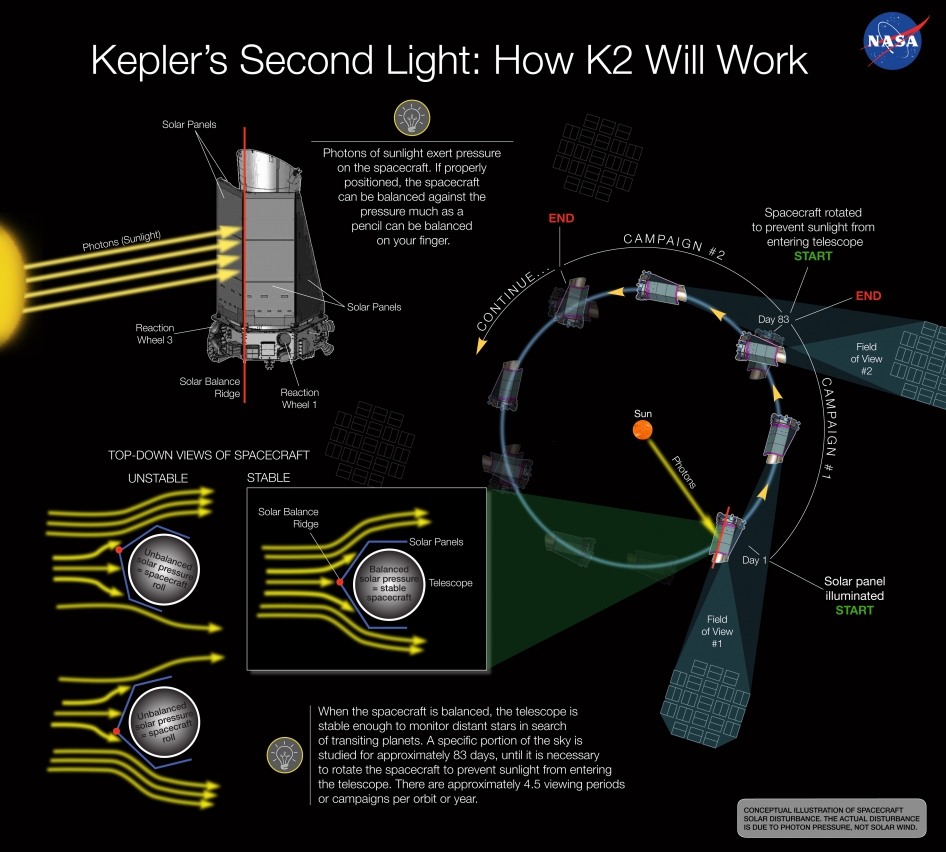
Between the launch of PLATO and Kepler's extended K2 mission will be NASA's TESS (Transiting Exoplanet Survey Satellite) mission which, like PLATO will use a similar "stare and step" method TESS is tentatively set for a 2017 launch and received good news in the form of the new NASA space science budget.
It will look for planets around nearby stars in both the northen and southern hemispheres. Alpha Centauri? Tau Ceti? Zeta Reticuli? Yep.... all on the "To Do List".
And just one year later in 2018 NASA's successor to the Hubble, the James Webb Space Telescope (JWST) will take flight. While the JWST is modest by ground based telescope standards its a HUGE upgrade over Hubble which will allow it to see and discover things Hubble never could:

Size comparison of Hubble and the JSWT
The James Webb Space Telescope and large ground based telescopes will examine the nearby planets which K2, TESS and PLATO discovered in closer detail, analyzing their atmospheres with the very real possibility of detecting the tell-tale signs of life.
The European Extremely Large Telescope (E-ELT) being constructed in Chile and scheduled for first light in 2022 will become the largest telescope in the world:

Size comparison of the E-ELT with the Very Large Telescopes and the Great Pyramids of Egypt.
There's a good chance that it and the JWST will be the first telescopes to discover life elsewhere in our galaxy among the nearby stars.
By the way. In the picture above the JWST's collector's size (6.5 meters) is just a little smaller than just one of the 8.2 meter mirrors in one of the Very Large Telescopes (the boxy Shaped things to the right of the E-ELT in the image next to the Great Pyramid above).
So imagine a slightly smaller one of those flying in space (and operating mostly in the infrared).
Like I said, we live in interesting times. Ever wonder what it was like to live in the time of Galileo or Copernicus?
Well you're in it, right now.
edit on 4-2-2014 by JadeStar because: (no reason given)
It will look for planets around nearby stars in both the northen and southern hemispheres. Alpha Centauri? Tau Ceti? Zeta Reticuli? Yep.... all on the "To Do List".
About time...
Very enjoyable thread. I appreciate the graphic showing the field of view for kepler. It's easy to forget how small the picture is for understanding (of what's around us). I don't believe I have seen it before compared to the solar system.
Side note: Why'd it take so long?
Trumpets of war go off and they spend countless dollars and man hours to launch bombs at each other, it's refreshing to see so many good projects in the works.
I thought we'd need a ship landing on earth soil before it happened. (Or did one? )
edit on 4-2-2014 by boncho because: (no reason given)
edit on 4-2-2014 by boncho because: (no reason given)
boncho
It will look for planets around nearby stars in both the northen and southern hemispheres. Alpha Centauri? Tau Ceti? Zeta Reticuli? Yep.... all on the "To Do List".
About time...
Very enjoyable thread. I appreciate the graphic showing the field of view for kepler. It's easy to forget how small the picture is for understanding (of what's around us). I don't believe I have seen it before compared to the solar system.
Thank you, I started to include one of the Kepler field of view as well, but i wanted to convey both what a small section of sky (near to us) and width of view (far from us ) Kepler covered. I didn't want to confuse people by just showing the field of view superimposed on constellations since the stars in constellations are at varying distances.
Here's the Kepler FIeld graphic showing where the Kepler field of view is in the Earths sky and just how small it is.....

Side note: Why'd it take so long?
Technology and funding....but mostly funding.
You see, we've had the basic technology to do the Kepler mission since the late 80s/early 90s but the funding wasn't there. Similarly we have the technology right now to snap a picture of another warm, wet, planet like Earth around another star but the funding isn't there for it.
In fact, the program was cancelled in 2006:
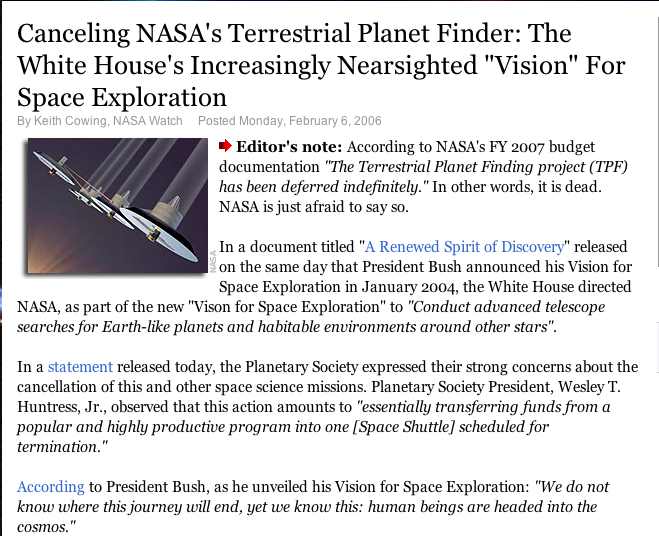
In fact another planet hunting mission that would have snapped pictures was also cut not long after that. The Space Interferometry Mission. Setting the idea of directly taking a picture of another terrestrial, Class M planet back probably a decade.
Kepler narrowly escaped the budget axe as well.
Then there's this....
We do have such images of many exoplanets (more than a dozen now), but those planets tend to be massive, distant from their star, and still glowing with the fire of youth—literally, they are still luminous from the heat left over from their formation. It’s different for an Earth-like exoplanet, one that’s a few billion years old, small, and a hundred million kilometers or so from its star. Separating it from that inferno of stray light is a Herculean task.
But not an impossible one. We already have designs on some pretty advanced telescopes that could do it. They could divvy out the handful of photons from the planet and the star and provide us with the image that could and should change humanity forever: A soft, faint green spark, floating next to a star not too terribly different from our own. And isn’t that why we want to do this? To see if there are other places for us, or places where others may actually be? Alien, for sure, but life.
So, finally, to answer the question posed at the beginning of this article: When will we find another Earth? The answer is: We may have already. And the statistics clearly show we’ll find plenty more in the next few years.
And when will we have a photo of this new Earth? That’s trickier, and I don’t know when that day will come. But it will be soon. The technology is within our grasp, should we choose to fund and build it. But we know how to do it, and in general things tend to happen once we first understand how.
Trumpets of war go off and they spend countless dollars and man hours to launch bombs at each other,
Agree wholeheartedly.
Unfortunately, the prime products of us primates are entertainment and war. Just visit a zoo... we're not that far from those little guys if you watch them closely, we just have iPhones and neutron bombs.
Think about how much money is spent just on one facett of entertainment: sports (which by the way I love so I am not knocking them).
The Super Bowl yesterday and the World Cup this summer will see tons of money change hands, over a game.
A silly 30 second, Super Bowl commercial advert cost $4 million USD.
One of these nifty little ExoPlanetSats will cost only $1 million dollars more: $5 million.
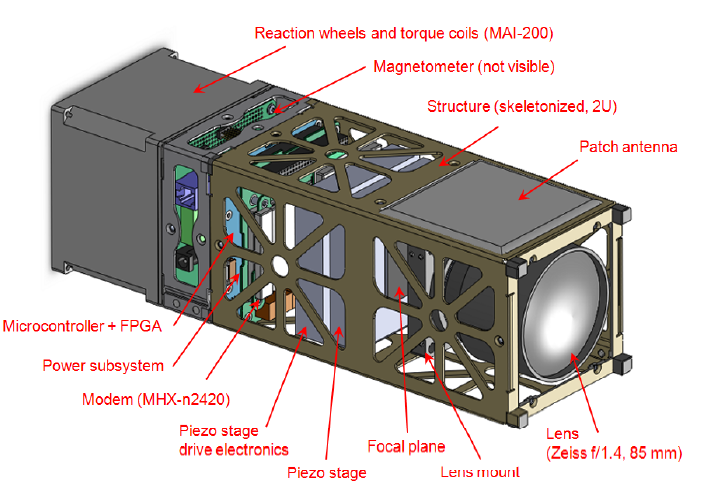
Will we really remember commercials from this year's Super Bowl or World Cup 5 years from now?
Nope.
But the catalogs these exoplanet hunters are making of habitable worlds, and future maps of their surfaces made around 2030 or so (sooner if there's an influx of cash), will be used by people 500 years from now just as astronomers use catalogs today made hundreds of years ago.
All a matter of priorities.
it's refreshing to see so many good projects in the works.
I thought we'd need a ship landing on earth soil before it happened. (Or did one? )
A landing, or even a signal or some other sign of life out there, esepecially intelligent life would certainly would free up some of the military industrial complex cash...
The fact that the NRO can just say to NASA "Here's two Hubble Space Telescopes which would cost you like 25 percent of your annual budget, we don't need them anymore, they're obsolete to us. We bought them with the Black Budget." .... says it all really.
edit on 4-2-2014 by JadeStar because: (no reason given)
Drake equalization part 2: While the chances of other life is extremely high, the chances to detect and contact/travel to other forms of life in the
time frame that they exist with the technology they develop in is infinitesimally small of being in the vacinity while being able.
reply to post by JadeStar
Wonderful news!
S+F!
Let's just hope no one starts yet another war to suck up Trillions out of all the dwindling budgets of more important programs that could benefit all of humanity as opposed to spending SO MUCH on ending the the folks the people in charge seem to think demand more attention and money than the development of future technologies that could put a number of us permanently out of reach of all the riff-raff.
erm. sorry. I got a little ranty.
I just wonder what our space programs could do if given the military budget of just one branch for just one year where such could equate to what's meagerly allotted over 10 years now.
Anyway, I sure hope to see this work go the distances planned.
Wonderful news!
S+F!
Let's just hope no one starts yet another war to suck up Trillions out of all the dwindling budgets of more important programs that could benefit all of humanity as opposed to spending SO MUCH on ending the the folks the people in charge seem to think demand more attention and money than the development of future technologies that could put a number of us permanently out of reach of all the riff-raff.
erm. sorry. I got a little ranty.
I just wonder what our space programs could do if given the military budget of just one branch for just one year where such could equate to what's meagerly allotted over 10 years now.
Anyway, I sure hope to see this work go the distances planned.
And to think when I was at school they were arguing if exoplanets even existed!
reply to post by JadeStar
JadeStar, what a great OP and thread. If ATS didn't have you we'd have to invent you.
JadeStar, what a great OP and thread. If ATS didn't have you we'd have to invent you.
AliceBleachWhite
reply to post by JadeStar
Wonderful news!
S+F!
Let's just hope no one starts yet another war to suck up Trillions out of all the dwindling budgets of more important programs that could benefit all of humanity as opposed to spending SO MUCH on ending the the folks the people in charge seem to think demand more attention and money than the development of future technologies that could put a number of us permanently out of reach of all the riff-raff.
erm. sorry. I got a little ranty.
No Alice, feel free to rant on if it is a good rant, and yours certainly was.
I just wonder what our space programs could do if given the military budget of just one branch for just one year where such could equate to what's meagerly allotted over 10 years now.
Well a good idea of that might be to look at the entire budget of the Apollo program from start to finish. That budget over its history equalled one year of the US Air Force or US Navy back in the 1960s.
Staggering.
And we're still reaping the benefits of technology that developed as a spinoff of that program today and that was 50 years ago.
We've been on "cruise control" ever since then. That's why those visions of the future that are now considered "fanciful" never materialized. If we had stayed on that course they probably would have.
We'd have an Elysium type space colony (probably built in the 1990s) right now.
Anyway, I sure hope to see this work go the distances planned.
Your post made me remember Carl "The Sage" Sagan's famous "Who Speaks For Earth":
edit on 4-2-2014 by JadeStar because: (no reason given)
new topics
-
Pentagon acknowledges secret UFO project, the Kona Blue program | Vargas Reports
Aliens and UFOs: 39 minutes ago -
Boston Dynamics say Farewell to Atlas
Science & Technology: 47 minutes ago -
I hate dreaming
Rant: 1 hours ago -
Is the origin for the Eye of Horus the pineal gland?
Philosophy and Metaphysics: 3 hours ago -
Man sets himself on fire outside Donald Trump trial
Mainstream News: 3 hours ago -
Biden says little kids flip him the bird all the time.
2024 Elections: 3 hours ago -
The Democrats Take Control the House - Look what happened while you were sleeping
US Political Madness: 4 hours ago -
Sheetz facing racial discrimination lawsuit for considering criminal history in hiring
Social Issues and Civil Unrest: 4 hours ago -
In an Historic First, In N Out Burger Permanently Closes a Location
Mainstream News: 6 hours ago -
MH370 Again....
Disaster Conspiracies: 6 hours ago
top topics
-
In an Historic First, In N Out Burger Permanently Closes a Location
Mainstream News: 6 hours ago, 14 flags -
The Democrats Take Control the House - Look what happened while you were sleeping
US Political Madness: 4 hours ago, 10 flags -
Thousands Of Young Ukrainian Men Trying To Flee The Country To Avoid Conscription And The War
Other Current Events: 16 hours ago, 8 flags -
A man of the people
Medical Issues & Conspiracies: 11 hours ago, 8 flags -
Man sets himself on fire outside Donald Trump trial
Mainstream News: 3 hours ago, 7 flags -
Biden says little kids flip him the bird all the time.
2024 Elections: 3 hours ago, 6 flags -
4 plans of US elites to defeat Russia
New World Order: 13 hours ago, 4 flags -
Is the origin for the Eye of Horus the pineal gland?
Philosophy and Metaphysics: 3 hours ago, 4 flags -
Sheetz facing racial discrimination lawsuit for considering criminal history in hiring
Social Issues and Civil Unrest: 4 hours ago, 3 flags -
Are you ready for the return of Jesus Christ? Have you been cleansed by His blood?
Religion, Faith, And Theology: 8 hours ago, 3 flags
active topics
-
-@TH3WH17ERABB17- -Q- ---TIME TO SHOW THE WORLD--- -Part- --44--
Dissecting Disinformation • 543 • : SideEyeEverything1 -
Elites disapearing
Political Conspiracies • 33 • : 0bserver1 -
Man sets himself on fire outside Donald Trump trial
Mainstream News • 29 • : ByeByeAmericanPie -
Fossils in Greece Suggest Human Ancestors Evolved in Europe, Not Africa
Origins and Creationism • 78 • : strongfp -
Pentagon acknowledges secret UFO project, the Kona Blue program | Vargas Reports
Aliens and UFOs • 2 • : Macenroe1982 -
In an Historic First, In N Out Burger Permanently Closes a Location
Mainstream News • 8 • : KrustyKrab -
12 jurors selected in Trump criminal trial
US Political Madness • 104 • : Annee -
Russian intelligence officer: explosions at defense factories in the USA and Wales may be sabotage
Weaponry • 175 • : Freeborn -
Thousands Of Young Ukrainian Men Trying To Flee The Country To Avoid Conscription And The War
Other Current Events • 36 • : Xtrozero -
Are you ready for the return of Jesus Christ? Have you been cleansed by His blood?
Religion, Faith, And Theology • 19 • : glend
11
